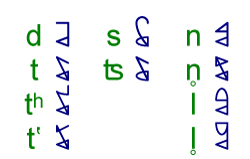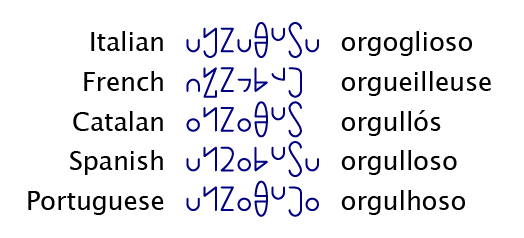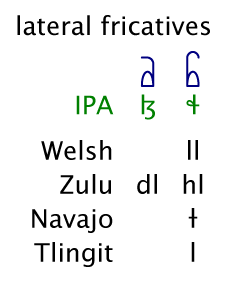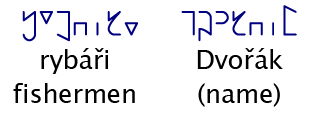 More Positions
More Positions
On the previous pages, you met 62 basic letters. But there are many more than 62 sounds in all the world's languages; many single languages have more sounds than that! To write most of the sounds in all of the world's languages, Musa replaces the tops or bottoms of some consonants to create more letters.
In English, we only use three general positions of articulation, and most languages use the same three:
-
Labial (bilabial or labiodental), using your lips
Coronal (dental, alveolar, or postalveolar), including the hissing and hushing sibilants, using the front of your tongue
Dorsal (velar or uvular), using the back part of your tongue
But there are other positions of articulation used in many languages, and Musa has bottoms for them:
-
Labiodental are made with your upper teeth against your lower lip.
For coronal sounds, apical sounds sometimes contrast with laminal sounds, and dental sounds sometimes contrast with alveolar or denti-alveolar sounds. We use alternate coronal and hissing bottoms to distinguish them.
Lateral sounds release air along the sides of your mouth.
Retroflex sounds are pronounced with your tongue flat or concave.
Palatal sounds are pronounced by raising the tongue towards the palate, as we do when we pronounce the letter y.
Labial-velar sounds involve co-articulation: both your lips and your velum are closed. These are not the same as labialized velar sounds like kʷ, which are normal velar sounds pronounced with your lips rounded.
Pharyngeal sounds are pronounced deep in your throat.
Labiodental Letters
On the last page, you met the bilabial fricatives bh and ph, which are made between your two lips. They're relatively rare, although for example bh occurs in Spanish and ph in Japanese. More languages have, instead, labiodental v and f, made between your upper teeth and lower lip. Ewe (Èʋegbe), a language of Ghana and Togo, has both sets: bilabial β and Φ and labiodental v and f, written with a hook on the bottom:

Musa also has letters for labiodental stops, oral and nasal, even though those sounds only occur allophonically or in affricates:

In addition, Musa has a letter for a labiodental approximant, a sound which appears in several languages; it's written ʋ in IPA . To pronounce it, put your mouth in position to say v, but say w instead.

Musa has several more letters for approximants that you'll meet below.
Labial-Velar Letters
A square bottom is used for labial-velar sounds, as found in many West African languages : kp and gb (as in the name of the Nigerian language Igbo) and nasal ŋm. They're not clusters - the two sounds are pronounced simultaneously.

We also use a square bottom to spell the velarized "dark l" we use at the end of English syllables, as in all. This contrasts with the "clear l" you met on the previous page. An example using both of them is the word lateral itself:
More Bilabial Letters
In addition to the basic bilabial letters, there are letters for bilabial sounds written with the zigzag top, even though they're not rhotic. Kom has a bilabial trill, not to be confused with the labiodental flap of Mangbetu :

This last letter is also used for bilabial flaps in some languages, so it could be called simply a labial flap.
Musa also has a letter for a bilabial approximant, like w but with no velarization:
Alternate Coronal Letters
The coronal consonants are all pronounced with the front of your tongue, but the exact articulation differs among several possibilities for both your tongue and the place it touches on the roof of your mouth. The active part of the tongue can be the tip ("apical"), the blade ("laminal"), the body bunched up ("domed"), or even the underside ("subapical"). The point of contact can be the upper teeth ("dental"), the upper gum ("alveolar"), both ("denti-alveolar") or further back ("post-alveolar").
We can indicate a precise articulation using orthophonic notation, but for normal orthography, it doesn't usually matter. For example, most English speakers use a laminal alveolar t, but if a Scot pronounces it as an apical dental, you might not even notice, or you'd notice that he has a Scots accent but still recognize it as a t. So we write all those coronal consonants with the letters you've already met.
But there are languages that distinguish between two similar coronal sounds. For example, Eastern Basque features both laminal dental s and ʦ (spelled x and tx) and apical alveolar s and ʦ (spelled s and ts).
Musa has a second set of letters for coronal sounds that are used to spell these pairs:

Interestingly, these letters are not assigned to a particular articulation. Instead, each language that needs them uses them for the less common set. In Basque, it's the apical alveolars that are less used, so we spell them with the letters for s and ʦ in the middle column. In Malayalam, it's also the apical alveolars that are rare, but in neighboring Tamil, it's the dentals that are rarer. So you can't tell by looking at them which articulation they are, but you know they're different from the principal set.
I don't show these alternate coronals in most of the charts and tables that follow, since they're not new sounds.
Retroflex Letters
The retroflex letters use the or bottoms. They're used in almost all of the languages of India, and in many other languages. For retroflex sounds, the tongue should be flat, concave or even curled upwards, to contrast with the palatal sounds, for which the tongue is pushed upwards to fill the mouth. There are retroflex versions of the plosives d t with sharp bottoms, and of the sonorants n l with smooth bottoms:

The sharp retroflex bottom is used for the common retroflex flap, while the rare retroflex trill uses a smooth retroflex bottom:

Retroflex affricates and sibilants use a rounded bottom (as do almost all affricates and sibilants).

That last letter also spells the northern pronunciation of Swedish sj.
On the Consonants page, I mentioned that letters for affricates replace stop+sibilant, even across morphemes; cat's and cats are spelled alike. But in cases where the stop and the sibilant have different positions, we write them differently. In the second Polish example below, we would combine them if the t were also retroflex.
Palatal Letters
Like the retroflex consonants, palatals also use two different bottoms: a sharp one for plosives, fricatives, and taps or flaps, and a smooth one for affricates, sibilants, trills, and alveolo-palatal nasals and laterals.
Many Romance languages have (alveolo-)palatal ns, as in Italian Spagna, French Espagne, Catalan Espanya, Spanish España and Portuguese Espanha. In Musa, those palatal ns are written using a letter with the nasal triangle on top and a closed arch on the bottom:

Italian, Portuguese, and Catalan also still have the (alveolo-)palatal ly (spelled as gl, lh and ll), although this sound has disappeared from French and from most Spanish dialects leaving just the semivowel y. (Many textbooks describe this sound as being the one from English million, but that's not correct : it's a y with your tongue pressed firmly against the roof of your mouth.)

The palatal ly isn't the same as the palatalized l. The two sounds contrast in Italian:

Musa also has letters for true palatal laterals and nasals (not alveolo-palatals):

In German, when the dorsal fricative kh (written ch) follows a front vowel, it becomes palatal, as in the words ich and nicht, but not Nacht. This is called ich-Laut :

Hungarian has unusual palatal plosives, ty and gy. Czech spells them t' and d', or more commonly t and d before i.

Alveolo-palatal affricates and sibilants use a rounded bottom:

A note on the use of retroflex and palatal sibilants: when a language has only two series, like English z s ("hissing") and zh sh ("hushing"), then they can be written and without worrying too much about the exact articulation of the back series. But when a language has three series, the two back series usually contrast retroflex and palatal. We would write for the "hissing" series, for the "rustling" series, and for the "humming" series. The corresponding affricates work the same way.
In Chinese, the velar plosives g and k have softened to palatal affricates (pinyin j q) before front i ue y and yw, and the velar fricative kh (pinyin h) has become a palatal sibilant (pinyin x), and we write all three of them with palatal letters. These contrast with both hissing dz ts s (pinyin z c s) and rustling dj ch sh (pinyin zh ch sh) :

Polish and several other Slavic languages also contrast three series of affricates/sibilants, for which we use the hissing, rustling, and humming letters. The humming series is soft; it incorporates the soft round suffix you'll meet on the Suffixes page:

Here's a full list of palatal letters :
Rounded Velar Letters
Most of the time, all the consonants we've discussed are pronounced with your lips spread, or at least neutral. But several languages distinguish variants pronounced with rounded lips. Linguists refer to this as labialization, but I think that's a misleading term, since they're not pronounced with a labial articulation like p b m; they're just pronounced with rounded lips, like the vowel u.
Almost any consonant can be rounded like that, but by far the most common are the velars and, to a lesser degree, the uvulars. American English speakers usually round their rs and their postalveolar sh zh ch dj, but not contrastively, so we don't bother writing it. Rounded lips are no less natural than other lip shapes! When we need to write it, Musa uses the w semivowel as a suffix.
But there are numerous languages that contrast rounded and unrounded velars, and in some rare cases even contrast the rounded velars with the sequence of velar+semivowel w. So for those languages, Musa offers a separate set of letters for velar sounds with rounded lips. In many of those languages, that is the only "cluster".
The Musa letters for rounded velars just replace the normal velar Ka bottom with a Li circle bottom. Here's a list:
| Unrounded | Rounded | ||
|---|---|---|---|
| g | | gʷ | |
| k | | kʷ | |
| ɣ | | ɣʷ | |
| x | | xʷ | |
| ŋ | | ŋʷ | |
Uvular Letters
Arabic ق has a famous uvular sound, the qāf in names like Iraq and Qatar. The Quechua languages also distinguish a uvular q from a velar k. Musa has five other uvular letters as well, used for sounds further back in your mouth than velar. Here they all are :

The uvular r is one of the many realizations of the guttural r, a phoneme in several languages whose exact pronunciation varies to include fricatives and unvoiced allophones.
Pharyngeal Letters
There are also sounds articulated between your uvula and your glottis, deep in your throat, like the sounds of the Arabic letters ع ayn and ح heh.

It used to be thought that there were two positions of articulation in the root of your throat, pharyngeal and epiglottal (also known as upper and lower pharyngeal). But now, linguists have decided that the only contrastive sounds - fricatives - actually contrast in manner, not position, since epiglottal fricatives are actually trills. So Musa doesn't distinguish pharyngeal from epiglottal sounds.
Lateral Letters
Musa has letters for coronal lateral fricatives, as occur in Welsh, Zulu, Navajo and Tlingit, for example:

The same bottom is used for lateral affricates, as in the unvoiced lateral affricate tl (from Navajo and Tlingit), the voiced lateral affricate dlz (from Oowekyala) and the lateral flap (from Venda or Japanese).

Lateral fricatives and affricates in other positions of articulation are written as digraphs. The first letter is one of the letters above with a closed-arch bottom - showing the manner and phonation - while the second letter is a normal lateral (approximant) letter, with a closed-arch top - showing the position. A font might even overlay the two arches to form a ligature.
Rhotic Letters
On the Vowels page, you met the semivowel, the semivowel version of the rhotic vowel. This letter encompasses several approximants, each of which has its own specific letter in Musa. In many of the languages that use them, they're not considered rhotic.

The superscripts in the IPA above aren't canonical, but those are the most common pronunciations.
Most sources analyze the Czech ř as an alveolar laminal non-sibilant fricative trill. We write it as a rhotic letter with a hushing bottom:
Rare Glottal Letters
On the previous page, you met the common glottal letters , but there are a few others, all very rare. One is a creaky-voiced glottal approximant; another two are voiced and voiceless nasal glottal approximants:
Approximants
An approximant is a sound that's made by constricting your mouth a little, but not enough to create turbulence in the flow of air - that would make it a fricative. On the vowels page, you met some semivowels - they're approximants. The laterals that aren't fricatives or affricates are also approximants.
But here we're going to meet some more approximants, written in Musa with a circle top. They're an odd group: the first three are labial and coronal, the middle four are rhotic, the next two are dorsal, and the last two are radical.

Musa also has approximant letters for w̬ and y̬ that are different from the semivowels w and y . They're rare, but can be used to spell the semivowels in cases where they conflict with the same letters being used as suffixes, for example Proto Indo-European w.
Another use is to spell approximants that are unspecified for rounding. For example, Spanish has both a semivowel y in words like abierto and hay, and an approximant y in words like tuyo and ayuda, in addition to its affricate y in words like ya and inyectar. Meanwhile, the g of pagar is also pronounced as an approximant w , and so are the b of habia as , and the d of adios as .
Recap
That's 65 additional letters, for a total of 127. Here's what you've seen so far (with transcriptions in IPA):

| < Consonants | More Voices > |
| © 2002-2025 The Musa Academy | musa@musa.bet | 19feb25 |






